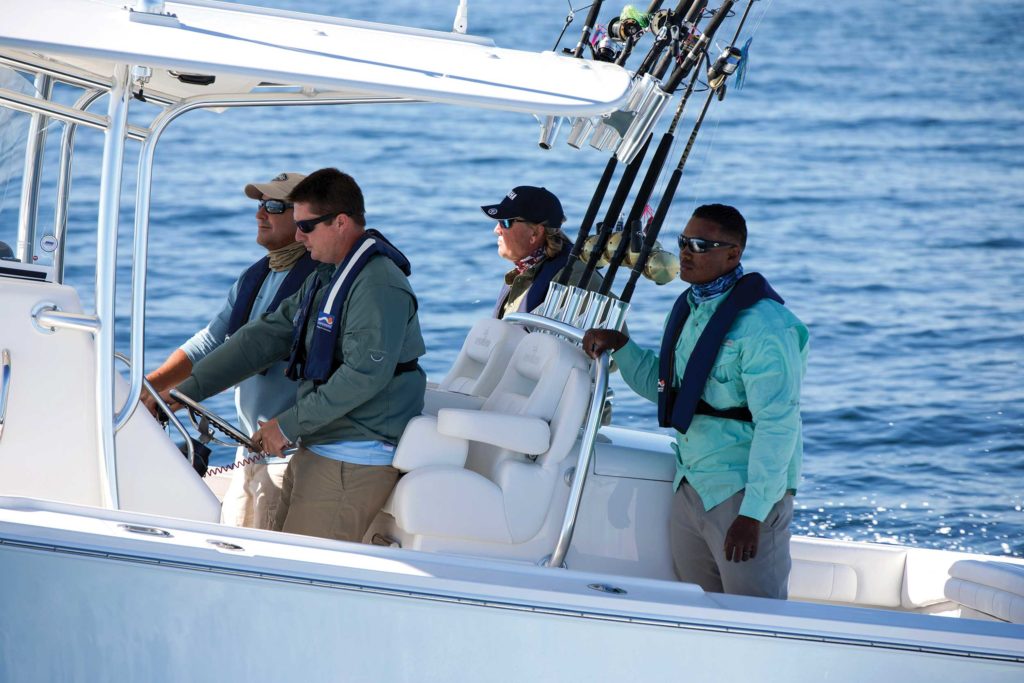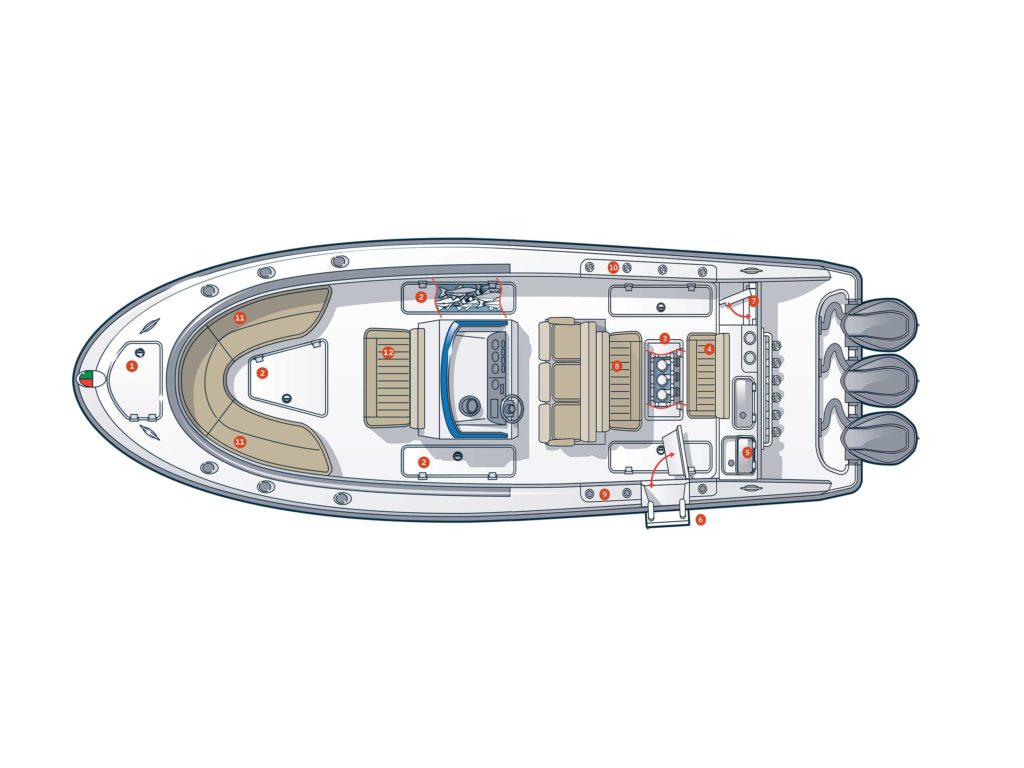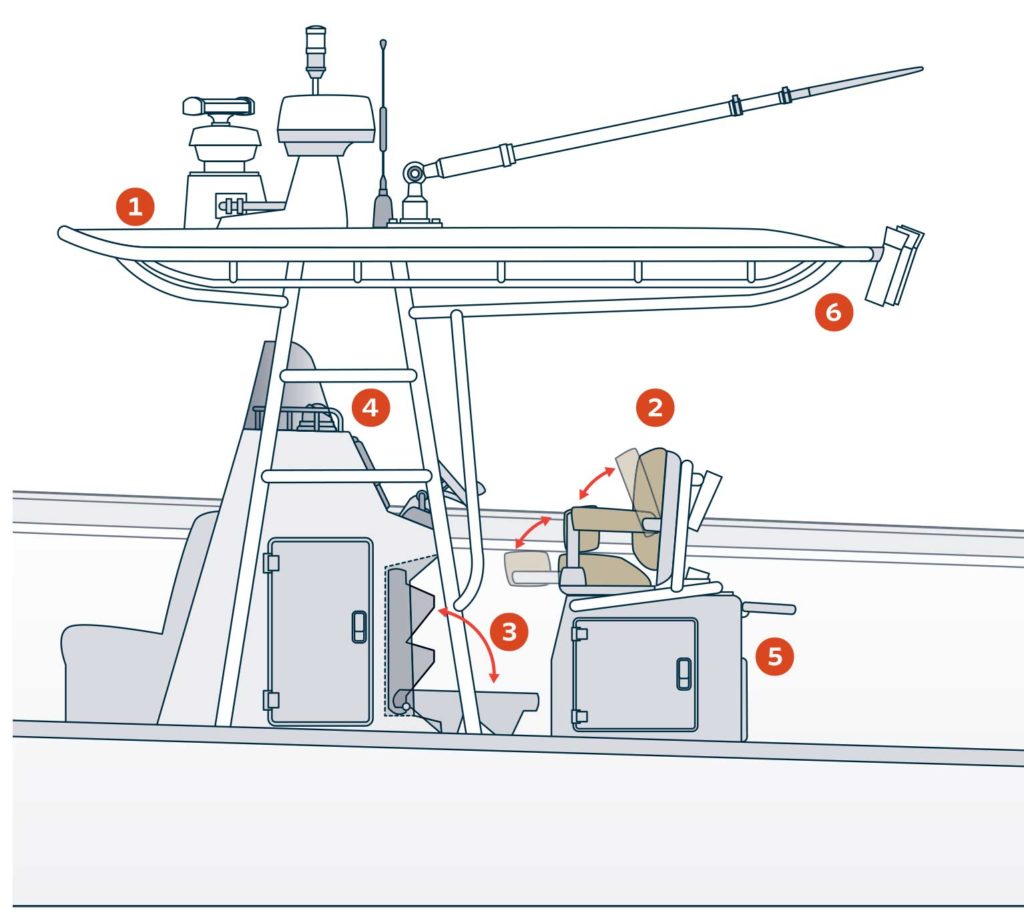
Quality is a function of design, construction and pinpoint targeting of features to the boat’s given application.
Design
Design brings features to the boat essential for comfort, fishability and performance. A center-console optimizes deck space for fishability and is most often selected by the most serious anglers. An express or walkaround design includes cabin features for overnighting but can impact fishability by reducing overall deck space. Those are the big strokes, but the small strokes in design are usually what make a good boat great. Step hulls represent another design element, one that can add performance, fuel economy and speed. One of the most popular step designs is the SVVT hull designed by Michael Peters. It offers speed, efficiency and lift, and includes special steps in the stern to eliminate the bad behavior of old step hulls that had a tendency to spin out in turns.
Design also speaks to how the fishability and comfort features are built into the boat.
Tournament anglers want a maximum number of rods rigged and ready so if one rig is damaged in the fight, another can be brought to bear in seconds. A weekend warrior might not have that many sticks, might not want that many hull penetrations for aesthetics, and doesn’t want to pay $500 or more per optional rod holder. The design features should incorporate ample seating for crew with enough firmness to support an adult in rough waters.
Dry storage should be dry. Too many manufacturers fall down here. Look for gutter rims tall enough to divert water, hatch gaskets to seal out water, and latches to batten the hatches.
Construction
Construction encompasses lamination schedule (the way the fiberglass and structures are laid in-), materials used and quality of hardware, and the convenient access for servicing all components.
A well-built boat will have no print-through of fiberglass matting in the gelcoat and no ripples in the hull from bulkheads bonded to it. Eliminating those requires careful construction and durable, high-quality resins.
Good construction also means optimal access to pumps in the bilge and wiring in the console. Some manufacturers fail to label wiring, making finding the right circuit a process of trial and painful error.
Good construction also means use of high-quality components. Hatches have to be supported either by friction hinges, which work well for smaller hatches and livewell lids, or by stainless-steel gas struts. Hinges must be through-bolted or special materials must be molded into the underside of the deck to firmly and permanently seat screws from the top.
Rod holders are best through-bolted with backing plates, and the hole angle should match the rod-holder angle. That takes a special jig to cut, and this provides support of the thick, sturdy material of the gunwale covering board.
Fishability
Fishability means different things to different anglers, simply because most anglers have their own unique style of pursuing their offshore gamefish.
Bottomfishermen need plenty of room for hooks, leaders and terminal tackle. Trolling for big game with ballyhoo requires convenient storage of frozen ballyhoo.
A rigging station with fresh water keeps your hands and the deck clean after rigging, and that makes everyone safer and more efficient.
A thorough self-awareness of your fishing tactics and social and entertainment needs will make your search for the ideal boat a successful quest.
Top 12 Features Your Offshore Boat Must Have

- An anchor windlass should have controls at helm and locker.
- Fish-box diaphragm pumps won’t jam due to hooks.
- Sea chests ensure steady livewell flow in step-bottom hulls.
- Stowable cockpit seating adds comfort and fishability.
- Acrylic livewell lids allow easy monitoring of baitwell.
- Side boarding doors with removable ladder yield easy entry.
- Transom doors aren’t essential with side doors.
- Mezzanine seats should also offer tackle-rigging area.
- Six gunwale, four shotgun and two bow rod holders are ideal.
- Extra rod stowage in gunwale, and along and inside console.
- Forward seating is essential in larger offshore boats.
- Bow seating with cooler beneath keeps deck clear.
Six Helm Essentials

- Better center-consoles now integrate T-top structure into consoles sides.
- Helm seating should allow comfortable driving, whether standing or seated.
- For shorter skippers, footrests can fold to the deck for added elevation.
- Consoles should be capable of holding instruments and dual nav displays.
- Behind the helm seating is an ideal place for tackle and tool storage.
- An optional darker color in the underside of the hardtop reduces glare.




